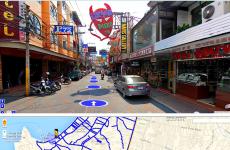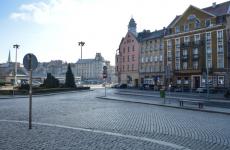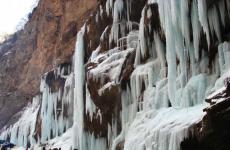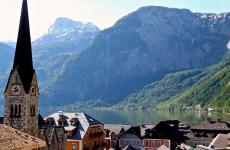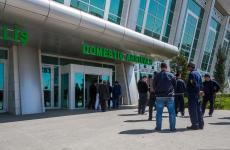National composition of the Crimean population for the year. Population of Crimea
List of the largest cities in Crimea: we briefly tell you why the cities are remarkable and what attractions you can see there.
Now on the Crimean peninsula, only 18 settlements have received city status, the largest of them in terms of area occupied are Sevastopol, Sudak, Yalta, Yevpatoria, Kerch and Simferopol.
Sevastopol is the largest city in Crimea
A large sea and commercial port, the largest city in Crimea, which has a special status and received the rights of a separate subject of the Russian Federation. According to 2015 data, the population was 398.97 thousand people - it is also the largest city in Crimea by population.
A huge number of attractions are concentrated here: the ruins of the ancient Greek settlement of Chersonesos, monuments of military eras (Russian-Turkish War, Great Patriotic War) and museums, a magnificent embankment, an Aquarium. Not far from the city is the cave monastery of Inkerman and Balaklava, the place where submarines were based. Sevastopol has a large number of picturesque bays.
Photo © mr. Wood / flickr.com
Once upon a time there was the capital of the Scythian state, which was later destroyed by the Goths. Simferopol is located in the central part of the peninsula and has no access to the sea. The Salgir River flows here.
Simferopol is the second largest city in Crimea by population after Sevastopol, with 332.6 thousand people living in it. Tourists in Simferopol are attracted by local attractions: the ancient site of Naples Scythian, Vorontsov Palace, Ethnographic Museum, Central Museum of Taurida, Kebir-Jami Cathedral Mosque, Weeping Rock, Chokurcha Cave, Red Cave (Kizil-Koba).

The third on the list of the largest cities in Crimea and the easternmost city of the peninsula, it is located on the shores of Kerch Bay. The local population is about 148 thousand people. The rich history of the city goes back more than 2.5 thousand years; there are a huge number of monuments of the Bosporan and Scythian kingdoms, Tmutarakan, and Byzantine villages. Kerch is a great hero city that has perpetuated the memory of the events of the Great Patriotic War in numerous monuments and memorials.

Photo © Alexxx1979 / flickr.com
An ancient city in the west of Crimea, population - just over 106 thousand. Evpatoria is one of the large cities of Crimea, located on the shores of the Kalamitsky Bay, there are wonderful sandy beaches and a warm, shallow sea. In Yevpatoria there are many entertainment centers, water parks, attractions, the Juma-Jami mosque, a monastery of dervishes, an ancient water supply system, Turkish baths, and ancient temples. Nearby is the city with healing mud Saki, which has a large number of health facilities.

Photo © Yuriy Kuzin / flickr.com
The most popular resort of the South Coast with a population of 78.2 thousand people is also the largest city on this coast of Crimea. The city has many hotels and holiday homes, there is a beautiful embankment, monuments, alleys, a local history museum, the Chekhov House Museum, the Yalta Zoo "Fairy Tale", "Glade of Fairy Tales", the Uchan-Su waterfall, the Massandra Palace, the famous winery "Massandra", not far from Yalta - Livadia Palace and Nikitsky Botanical Garden.

Photo © B. Rad / flickr.com
Feodosia is an ancient city located in the southeastern part of the peninsula, founded by Greek colonists. Now about 70 thousand people live here, which makes this settlement one of the largest in terms of population in Crimea. There are few ancient buildings here, the excavations that have begun make it difficult for residential areas, so the main architectural monuments have been preserved from the Middle Ages: the remains of the citadel of the Genoese fortress, the walls of Hayots Berd, Armenian temples and the Armenian fountain, the Mufti-Jami mosque. Art connoisseurs will enjoy the Alexander Greene Literary and Memorial Museum and the National Art Gallery of the famous marine painter I.K. Aivazovsky.

Photo © naiv.super1 / flickr.com
Dzhankoy
An important railway junction in the northern part of the peninsula. According to the latest data, the population was about 39 thousand people. Shallow rivers flow through Dzhankoy and there is no access to the sea. The city is not rich in attractions: the Kalinovsky landscape park, home to more than 100 species of birds, a mosque, the Holy Protection Orthodox Church and a local history museum.
Alushta
A well-known resort city on the southern coast of Crimea, the population is about 30 thousand people, which is much less than in Yalta, but nevertheless Alushta is one of the large cities of Crimea. Alushta has many beaches and attractions, an aquarium, a dolphinarium, a nature museum and an arboretum, not far from the city (near the village of Luchistoye) Mount Demerdzhi and the famous Valley of Ghosts.

Photo © lazy_lizzy / flickr.com
Bakhchisaray
Former capital of the Crimean Khanate. The city with a population of just over 27 thousand people is located in the steppe zone of Crimea in the foothills. The main attraction is the Khan's palace Khansaray. No less interesting for tourists are the Fountain of Tears, glorified by A.S. Pushkin, mosques and the cave city of Chufut-Kale.
Krasnoperekopsk
An industrial city in Crimea (specializing in chemical production), with a population of just over 26 thousand people. Located in the southern part of the Perekop Isthmus, the North Crimean Canal passes nearby.
Recent events have drawn public attention to the political preferences of the population of Crimea. To a large extent, they are determined by the ethnic composition of the current autonomous republic within Ukraine.
The evolution of the ethnic structure of the Crimean population is presented in the following graphs and table. It should be noted that the first graph “Population of Crimea”, borrowed from Wikipedia, does not contain data from the 1970 census, but there are columns relating to April and July 1944 - before and after the deportation of the Crimean Tatars 18-20 May 1944. The second graph and the table “Population Structure of Crimea” contain data from the 1970 census, but there are no quantitative estimates of the ethnic composition of the population in April and July 1944.

Population of Crimea in
XVIII
-
XXI
centuries
| Dates
Total, thousand, people |
As a percentage of the total population: | |||||||
| Crimean Tatars, Turks, Tatars | Crimeans, Karaites, Jews | Greeks, Armenians, Bulgarians, Belarusians, Moldovans, Georgians | Ukrainians | Russians | Germans, Poles, Hungarians | Other | ||
| 1st quarter 18th century | 467,0 | 95,1 | 0,2 | 4,7 | ||||
| 1760-70s | 454,7 | 92,6 | 0,3 | 7,1 | ||||
| 1793 | 127,8 | 87,8 | 12,2 | |||||
| 1795 | 156,4 | 87,6 | 2,3 | 2,6 | 1,3 | 4,3 | 0,1 | 1,8 |
| 1816 | 212,6 | 85,9 | 2,3 | 2,5 | 3,7 | 4,8 | 0,7 | 0,1 |
| 1835 | 279,4 | 83,5 | 2,0 | 3,9 | 3,1 | 4,4 | 0,7 | 2,4 |
| 1850 | 343,5 | 77,8 | 2,2 | 3,5 | 7,0 | 6,6 | 1,0 | 1,9 |
| 1858 | 331,3 | 73,0 | 2,6 | 4,3 | 4,0 | 12,6 | 1,5 | 2,0 |
| 1864 | 198,7 | 50,3 | 7,0 | 11,0 | 7,2 | 21,3 | 2,7 | 0,5 |
| 1897 | 546,7 | 35,9 | 4,4 | 5,9 | 11,8 | 33,1 | 7,0 | 1,9 |
| 1917 | 749,8 | 29,4 | 6,4 | 5,9 | 8,6 | 41,2 | 5,7 | 2,8 |
| 1920 | 718,9 | 26,0 | 7,5 | 6,5 | 7,4 | 44,1 | 6,7 | 1,8 |
| 1926 | 713,8 | 25,1 | 6,1 | 5,4 | 10,9 | 42,2 | 6,1 | 4,2 |
| 1934 | 832,0 | 23,8 | 8,1 | 3,1 | 10,9 | 44,0 | 6,1 | 4,0 |
| 1937 | 996,8 | 20,7 | 5,8 | 3,7 | 12,9 | 47,7 | 5,1 | 4,1 |
| 1939 | 1123,8 | 19,4 | 5,8 | 4,3 | 13,7 | 49,6 | 5,0 | 2,2 |
| 1944 (late summer) | 379,0 | 0,0 | 21,0 | 75,0 | 4,0 | |||
| 1959 | 1201,5 | 0,0 | 2,2 | 2,3 | 22,3 | 71,4 | 0,1 | 1,7 |
| 1970 | 1813,5 | 0,4 | 1,4 | 3,9 | 26,5 | 67,3 | 0,2 | 0,3 |
| 1979 | 2135,9 | 0,7 | 1,1 | 2,7 | 25,6 | 68,4 | 0,3 | 1,2 |
| 1989 | 2430,5 | 1,6 | 0,7 | 3,0 | 25,8 | 67,0 | 0,3 | 1,6 |
| 2001 | 2024,1 | 12,0 | 0,3 | 2,6 | 24,3 | 58,3 | 0,4 | 2,1 |
Data for Russians and Ukrainians in 1864 - estimate.
Data for all years except 2001,- for the entire peninsula, data for 2001- only for the Autonomous Republic of Crimea.
Changes in the ethnic composition of the population of Crimea provide food for more than one publication. At the moment, I think it is possible to dwell on only a few observations.
1. Crimea is one of the territories of the former Russian Empire/former USSR that has experienced radical changes in its ethnic composition in the last two and a half centuries.
2. The key factor in radical changes in ethnic composition is changes in the nature of the dominant political regime and in the political situation.
3. Before the annexation of Crimea by Russia (1783), the Crimean Khanate was an almost monoethnic state; Crimean Tatars made up over 92% of the total population.
4. Crimean Tatars remained the absolute majority on the peninsula (over 50%) until 1864, and also a relative ethnic majority until the end of the 19th century (about 36% in 1897).
5. Over the course of about a century and a half (1783 - 1944), the Crimean Tatars experienced three major demographic catastrophes - after the annexation of Crimea to Russia (1780-90s), after the Crimean War (1850-60s), May 18-20, 1944 As a result of the first demographic catastrophe (primarily emigration), the size of the Crimean Tatar population in Crimea decreased fourfold, as a result of the second (emigration) - its number was halved from what was on the eve of the Crimean War, as a result of the third ( deportation) - almost all Crimean Tatars were evicted from Crimea.
6. In the second half of the 1980s, the return of the Crimean Tatars to their historical homeland began. According to the 2001 census, their number in Crimea was 243 thousand people, or about 45% less than there were on the peninsula for three centuries at the beginning of the 18th century. Taking into account natural and mechanical population growth, the number of Crimean Tatars by the beginning of 2014 may have approached 300 thousand people.
7. Since the beginning of the 20th century (1917), the largest ethnic group in Crimea in relative terms (over 41% of the total population) has been Russians. They became the largest ethnic group in Crimea in absolute terms (75%) in 1944 after the total deportation of the Crimean Tatars.
8. Over the next six decades, the share of Russians in the population of Crimea gradually decreased. According to the 2001 census, the share of Russians in the population of the Autonomous Republic of Crimea was 58.3%. Over 12 years, from 1989 to 2001, the number of Russians in the “big” Crimea (a hypothetical union of the Autonomous Republic of Crimea and the city of Sevastopol, which has a special administrative status) decreased by 179 thousand people, or by 11%. The share of Russians in the population of the “greater” Crimea for 12 years decreased from 67.0% to 60.4%.
9. Taking into account the demographic trends of the last 13 years, Russians in 2014 obviously make up approximately half of the population of the Autonomous Republic of Crimea (excluding the city of Sevastopol). It is possible that according to the results of the new census of Ukraine expected in 2016, Russians will make up less than half of the population of the peninsula (excluding the city of Sevastopol).
10. In the foreseeable future, in the absence of serious military-political cataclysms, Crimea will remain a region with a clearly defined multi-ethnic composition of the population, with Russians, Ukrainians, and Crimean Tatars remaining the largest ethnic groups.
The city of Crimea belongs to the Russian state. It is a peninsula located in the west of our country. The Crimean territorial border includes the city of Crimea itself, as well as the city of Sevastopol. The Crimean peninsula is unique; it attracts hundreds of thousands of vacationers and tourists. Every year, visitors plunge into the wonderful nature of the peninsula and enthusiastically enjoy the beauty of the Azov, as well as the Black Sea. The Crimean peninsula cannot be called huge, but the population of Crimea in 2019 is about 2,000,000 people. It is important to clarify that together with the city of Sevastopol, the population of the two territorial units is approximately 2,300,000 people.
Population of Crimea
The unique and beautiful Crimean peninsula attracts hundreds of thousands of visitors every year. Of course, most of the tourists are seen here in the summer season, but these days some Russians already prefer to have Crimea as their permanent place of residence. The population of Crimea in 2019 is about 2,000,000 people. It is important to clarify that such a ratio is indicated without including the total population of Sevastopol.
If we take historical data, the total number of local residents has approximately doubled compared to 1959. The population of Crimea is gradually arriving, and the explanation for this is the huge number of newcomers and the excellent birth rate on the territory of this peninsula.
As for the various nations that live in Crimea, there are a sufficient number of them. Among the local residents you can see Russians, Ukrainians, Gypsies, Turks, and Jews. This city beckons and attracts, this is what explains its development and population growth. Of course, the majority of the population of this territorial unit is occupied by Russian residents; their total number in comparison with other nations indicates a ratio of 67%. It is important to clarify that such a figure was not present at all times; for example, in 2001, the Russian population of Crimea was about 55%.

The population of Crimea for 2019 has the following characteristics by nationality:
- the Russian population accounts for about 65% of the total population;
- Ukrainians occupy about 16% of the same ratio;
- Tatars account for about 12% of the total Crimean population;
- About 1% of Belarusians live in Crimea;
- Armenians occupy only about 0.5% of the total population;
- Other nationalities account for approximately 2.5% of the total population of Crimea.
Statistics show that about 55% of the population are indigenous to Crimea; approximately 15% of the current population were previously citizens of various constituent entities of the Russian Federation; approximately 16% of residents were previously listed as Ukrainians.
The Crimean Peninsula is famous and universally loved. Historical data indicates that the remains of ancient people were found on the peninsula, which means that the peninsula was densely populated by our ancient ancestors. During the duration of the Great Crimean War, it was the inhabitants of this peninsula who continued to maintain friendly relations with Russia, when many other countries simply turned their backs on it.

The uniqueness of Crimea lies not only in historical data. To this day, this peninsula is considered a troubled territorial unit. It is not uncommon for several strong earthquakes to occur here over the course of a full year. But the earthquake that occurred in 1927 destroyed most of the infrastructure of Crimea, which was subsequently successfully reconstructed by friendly and united local residents.
As a source, I used a useful article from Wikipedia “Population of Crimea”.
The article presents the results of population censuses for 1897-2014, and the abundance of tables always makes the text interesting.
Let's not look into the century before last, but it would be interesting to compare the results of the last Soviet census of 1989, the Ukrainian census of 2001 and the census conducted in Crimea in 2014.
The first table shows the national composition of the population of the entire Crimea (Republic and Sevastopol). I slightly changed the original table from Wikipedia, bringing together the East Slavic, Tatar and Jewish peoples. Nations whose share in the population of Crimea has increased over the period 2001-2014 are indicated in green.
Table 1. National composition of the population of Crimea according to census data.
As you can see, in the population of Crimea after joining the Russian Federation, the share of Russians noticeably increased, while the absolute number and proportion of Ukrainians and Belarusians sharply decreased. I believe that the reason for this jump is quite clear.
In general, the share of Eastern Slavs in the population of the peninsula has decreased over 25 years from 95 to 81 percent.
The share of Tatars increased sixfold between 1989 and 2014. According to Rosstat, part of the Crimean Tatars called themselves Tatars during the census. The appearance of the Turks is noteworthy.
According to the census, only 0.17% of the population of Crimea remained Jews.
In addition to the Tatars, there are five more peoples whose numbers are growing in Crimea. These are Armenians, Azerbaijanis, Uzbeks, Tajiks and Gypsies.
It is noteworthy that the share of those who did not indicate their nationality during the census increased in 2014 to 3.82%, compared to 0.82% during the Ukrainian census of 2001.
Table 2. National composition of the urban and rural population of Crimea as a percentage of the total.
Table 2 shows the shares of the number of people who indicated their nationality, and not of the total number of Crimeans. Therefore, the data for Crimea as a whole are somewhat different from the data in Table 1.
As we can see, in rural areas the share of Russians is significantly lower than in cities. On the contrary, the share of Tatars and Ukrainians is significantly higher in rural areas.
Table 3. How many times has the share of a particular national group increased (decreased) in 2001-2014.
As we can see, the share of Russians in the urban population increased by 13% during the period between the 2001 and 2014 censuses, and the share of Russians in the rural population increased by 22%. This is not surprising, because The share of those who called themselves Ukrainians and Belarusians in rural areas was initially higher, but with the change in the political situation everything fell into place.
What is important is the fact that the Tatar population moved significantly from the village to the city.

Table 4. National composition of urban districts and rural areas of Crimea.
Table 5. National composition of urban districts and rural areas of Crimea as a percentage of the total.
The highest values in the columns are highlighted in bold.
An interesting fact is that the proportion of those who did not want to indicate their nationality during the 2014 census in some cities of Crimea turned out to be quite high. In Yalta there were 9.2%, in Simferopol 5.8%, in Sevastopol 4.9%. The proportion of those who did not indicate their nationality is high in Armyansk and Alushta.
I tried to determine the dependence of the proportion of those who did not indicate their nationality on the proportion of persons of one or another nationality in the population of cities and regions of Crimea.
It turned out that the share of those who did not indicate their nationality correlates most closely with the share of Tatars (with the total number of Crimean Tatars and “just” Tatars). Moreover, the dependence is negative. The smaller the proportion of Tatars in a given territory, the greater the proportion of people who did not indicate their nationality.
From this, of course, it does not follow that all those who did not want to indicate their nationality during the 2014 census are Tatars, but this possibility should be taken into account.
Therefore, I think it will be interesting to look at the tablet, which brings together data on the number of Tatars (Crimean Tatars and “just” Tatars) and persons who did not want to name their nationality.
Table 6. Changes in the number of Tatars by urban districts and regions of Crimea.
According to the census, the number of Tatars in Crimea over 13 years has increased by less than 19 thousand people, or only 7%. But, if we assume that a significant part of those who did not indicate their nationality are Tatars, such an estimate of the growth rate of the Tatar population may turn out to be very underestimated. Particularly important is the fact that the bulk of those who did not wish to indicate their nationality were in Simferopol, Sevastopol and Yalta.
So, 2/3 of the population of Crimea are Russians, every seventh is Ukrainian, every eighth is Tatar. But, taking into account those who did not want to indicate their nationality, there may be significantly more Tatars. And the reduction in the total number of Russian residents of Crimea, which has not yet been overcome, is accompanied by an increase in the number and concentration of the Tatar population in large cities. There is probably nothing dramatic about this, but it is an interesting trend and should certainly be taken into account.
